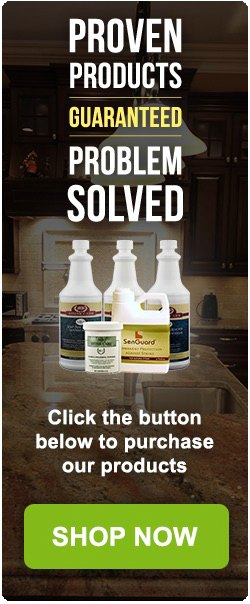How To Get Stains Out of Concrete Countertops
Don’t panic, and don’t experiment. You can get stains out of concrete countertops in most cases. But it’s critical to first determine the type of stain and then choose the proper method to remove or fix it.
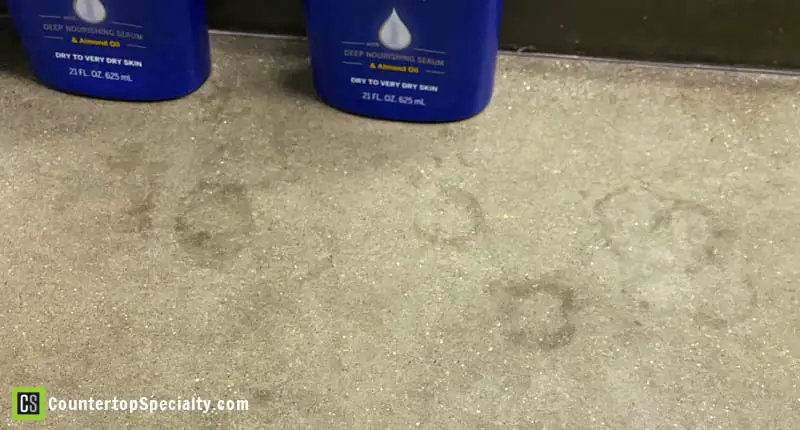
- A pH-neutral cleaner or detergent and scrubbing will remove most stains from food.
- Bleach may be effective for stubborn stains but use it carefully.
- A poultice is needed for oil or deep stain removal.
- Etch marks from acidic foods and cleaners require countertop repair.
- Hard water stains are removed with a specialty cleaner.
- All methods are explained below.
oN THIS PAGE
To avoid stains and damage learn about cleaning concrete countertops correctly.
How To Remove Surface Stains From Concrete Countertops
Countertop surface stains are darker spots from food and drink residues or spills that remain on top of the sealer or wax and have not been absorbed into the concrete.
Deep stains have penetrated the sealer and absorbed into the pores of the concrete kitchen countertop.
Chalky white or rough spots are different. These are etch marks caused by acidic liquids, foods, or harsh cleaners and require a different repair method (see the specific section further below).
Sometimes a substance can cause both a rough etch mark and a dark spot stain. For instance, wine, coffee, and mustard are all acidic. A spill could etch the concrete and then also leave a dark or discolored spot.
Here's how:
- First, spray the stain with a quality pH-neutral stone cleaner and scrub lightly with a non-abrasive sponge or soft cloth. This will remove most stains. Dish soap and hot water can work, but soap leaves a dull residue when used as a regular cleaner.
- For stubborn stains, wet a folded paper towel with bleach and set it on the concrete stain.
- Place a drinking glass or heavy cup on the paper towel to ensure complete contact and keep the bleach from evaporating.
- Check the stain every 5 minutes until the stain is gone. Checking frequently is essential as prolonged contact with bleach may damage the sealer or surface creating a greater problem.
- Rinse thoroughly with water and wipe dry.
- Clean the area with your countertop cleaner to remove remaining bleach residue and buff dry.
Tip: Bleach can be applied for a short time in many cases without a problem. But note that bleach can sometimes cause etching or discoloration on cement, so you should test a drop of bleach on an inconspicuous area first.
How To Remove Oil & Grease Stains From Concrete Countertop
Concrete is porous. Liquids, grease, and oil can absorb deep into the countertop if spills are not cleaned up. This can occur even when the top has been sealed. Such tough stains cannot be removed by scrubbing with a cleaner.
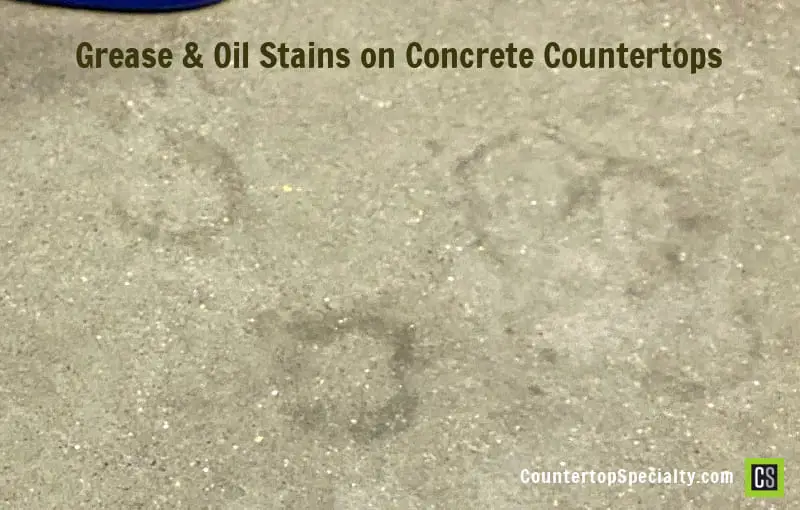
Removing an oil stain, grease, and deep or embedded stains from foods or drinks requires a more involved process, but this cheap and simple procedure will do the trick.
- Make a poultice by mixing flour and acetone into a paste the consistency of peanut butter. Or use this pre-made professional Stain Remover Poultice.
- Spread the paste over the stain. The paste should be about ¼” thick.
- Cover it with plastic wrap and seal it all by taping down the edges.
- Let it sit for 24 hours, then remove the plastic wrap but don’t touch the poultice.
- Leave the poultice on the stain until completely dry and hard. This may take another 12 to 24 hours or more. The evaporation is what draws out the stain so be patient.
- Remove the dry poultice, clean the area, and inspect. The stain should be lighter or gone.
- Repeat the process if needed. Multiple applications are often necessary.
Sometimes multiple applications are needed depending on the depth and severity of the stain. Baking soda or talc may be used instead of flour. Hydrogen peroxide may work better than acetone for some stains, especially oil.
The pre-made professional Stain Removal Poultice product simplifies the process.
For a rust stain, use the Rust Stain Removal Poultice.
The Granite & Marble Stain Removal ebook provides proven methods to remove stains made by all types of substances.
Acetone or hydrogen peroxide will not work to remove every type of stain.
Some poultices require different active ingredients depending on what substance causes the stain.
When comparing concrete vs. granite many characteristics are different, however, the same stain-removal methods work on concrete, granite, or any porous hard surface.
Note: Some chemicals and solvents may damage certain concrete sealers like topical resin-based sealers such as acrylics, epoxies, and urethanes.
Check if your sealer can handle acetone by placing a small drop in an inconspicuous area, noting any surface changes. If acetone does harm it, you will likely need to re-seal the area after stain removal.
How do you remove acid etching stains from concrete?
Contact with an acidic liquid like juice, wine, coffee, vinegar, fruits, tomatoes, other foods, and many cleaners will cause dull, light-colored, rough, and pitted spots on concrete countertops. The same thing can happen on a stone countertop like marble.
Etching is physical damage to the countertop. It’s a chemical burn. So, an etch mark is not the same as a “stain”. Stains are always dark spots. Etching is chalky or lighter in color. Concrete surface repair is required in a similar manner as etching on honed marble.
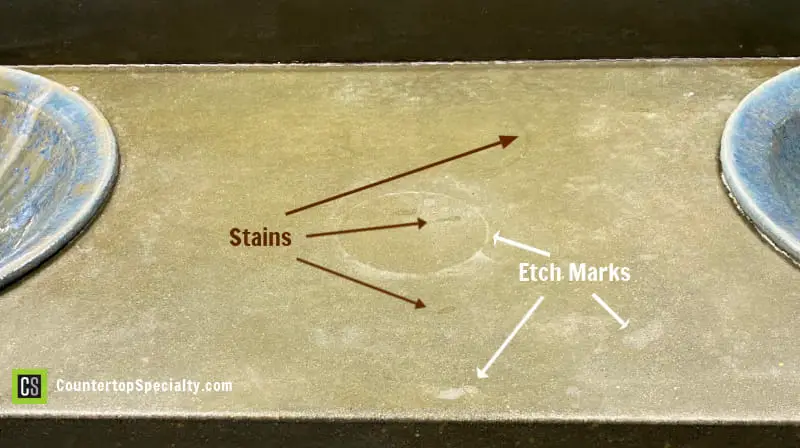
The following concrete countertop care instruction focuses on treating mild etching where the top is still basically level and not too rough or pitted.
Directions:
- Wet the etched area. Dry sanding can burnish the concrete mix making it look different than the surrounding surface
- Use an 800-grit diamond hand pad for sanding the etched area.
- Frequently wipe away accumulated particles and re-wet the area
- Switch to a coarser 400-grit pad if the 800-grit is slow-going or doesn’t smooth the area
- This Etch Remover Marble Polishing Pad Manual Kit will make the process easier with step-by-step instructions. Works just as well on concrete.
- Re-apply a sealant if needed.
For larger etched areas or deep etching, you may have to hone and polish the area again. Often you’ll need to replace the damaged surface with grout. Then hone the grout level with a fine-grit diamond polishing pad (400-grit or 200-grit). For a polished finish, use 800 and 1600-grit pads and re-apply a quality penetrating sealer.
Repairing deep or extensive etching is complex, and it may be best to hire a professional.
Cleaning Hard Water Stains
Using a non-acidic Hard Water and Soap Scum Cleaner will safely remove hard water stains from concrete countertops without damage. Works on soap scum too.
- Apply the Hard Water Remover product
- Let it soak on the hard water stain for 5-10 minutes,
- Scrub with a non-abrasive pad, brush, or sponge.
Water from wells and some city water supplies may contain a high concentration of minerals called “hard water”. When the water around the faucet or sink evaporates, these minerals are left behind, forming a chalky or yellowish film.
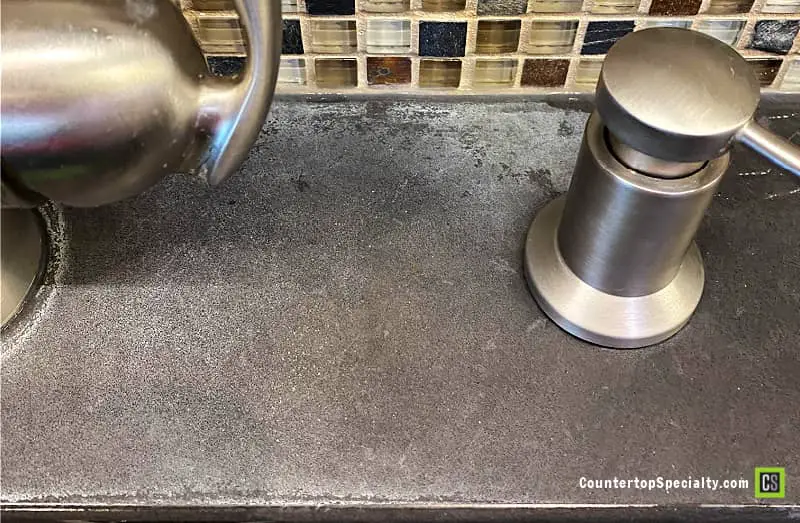
Hard water minerals adhere tenaciously to the countertop and typically cannot be removed with a regular cleaner. A specialty cleaner is required. But not all calcium or limescale cleaners are safe for use on concrete countertops.
The hard water cleaner recommended above is a non-caustic formula that won’t damage a concrete counter. Most other cleaners available like Lime-Away or CLR are too acidic and will etch.
All types of countertops will stain in one way or another. And not all stains are the same. Follow the different remedies outlined above, and you’ll maintain your concrete countertops in excellent condition. The same methods will work on a concrete floor as well.
FAQ: How To Get Stains Out of Concrete Countertops
How do you get water rings out of concrete?
Water rings and white spots are etch marks that require surface repair. Etch marks are spots of chemical corrosion from acidic foods or harsh cleaners. To get water rings and white spots out of concrete wet sand the water rings with 400-grit and/or 800-grit diamond pads until the ring is gone and the spot is smooth. Etch Remover Marble Polishing Pads work well too.
Do concrete countertops stain easily?
No. If a sealant is correctly applied, waxed, and maintained and spills cleaned up, then cement countertops will not stain easily. However, an oil stain, food stain, or acid stain could occur if the sealer is scratched or damaged or if a substance is left to sit and absorb.
How to prevent concrete countertops from staining?
To prevent staining properly apply a concrete countertop sealer and the correct wax, wipe up spills quickly, use cutting boards to avoid scratching the surface and sealer, and minimize contact with acidic foods that etch and damage the finish.
Do sealed concrete countertops stain?
Yes. It is still possible to get a stain in sealed concrete countertops. A concrete sealer will dramatically improve stain protection by making it harder for liquids to absorb but not impossible. A topical coating sealer will prevent stains unless scratched or damaged. An impregnating sealer slows down absorption, so you have more time to clean spills. But if spills are not cleaned up, a stain could still occur.

